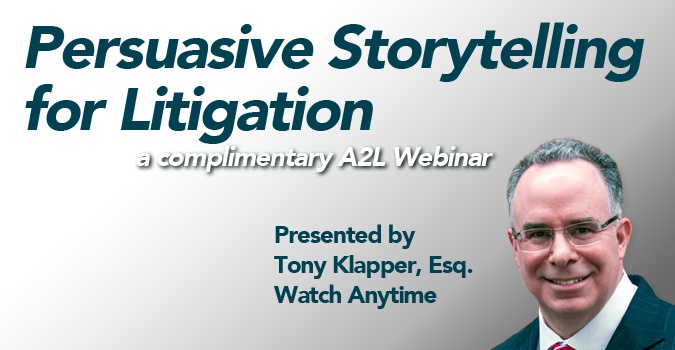Discover why using bullet points in PowerPoint presentations can hinder your ability to persuade and learn powerful tips to enhance your presentations.
The Problem with Bullet Points: How They Kill Persuasion
Bullet points have long been a staple of PowerPoint presentations. However, their overuse can actually hurt your ability to persuade and engage your judge/jury. Bullet points are often used as a crutch, allowing presenters to simply read off the slide instead of creating a compelling narrative. This can lead to a lack of connection with the judge and jury and a diminished impact of your message. Additionally, bullet points can make your presentation feel cluttered and overwhelming, making it difficult for your judge & jury to focus on key points.
We have written extensively about this in articles such as, Still Think Persuasion is About Talking While Showing Bullet Points? and 12 Reasons Bullet Points Are Bad (in Trial Graphics or Anywhere) and Why Reading Your Litigation PowerPoint Slides Hurts Jurors and The Redundancy Effect, PowerPoint and Legal Graphics. They are wonderful resources all by themselves.
To overcome the problem with bullet points, consider alternative ways to present information. Instead of listing out your main points in bullet form, try using visuals, storytelling techniques, effective data visualization, and memorable quotes and anecdotes to drive your message. Above all else, never read your slide aloud
Engaging Visuals: Captivating Your Judge and Jury with Compelling Images
One of the most powerful ways to enhance your PowerPoint presentation is by incorporating engaging visuals. Instead of relying solely on words, use compelling images, charts, and graphs to convey your message. Visuals can help capture your judge or jury's attention and make your presentation more memorable. They can also convey complex information in a simplified and easy-to-understand way. When choosing visuals, make sure they are relevant to your message and reinforce your key points.
To create engaging visuals, consider using high-quality images, infographics, and animations. These can help create a visually appealing and dynamic presentation that keeps your judge or jury engaged from start to finish. Here, consider using professionals who do this all the time like Persuadius.
Storytelling Techniques: Crafting a Narrative to Drive Your Message
Storytelling is a powerful technique that can captivate your judge/jury and make your presentation more persuasive. Instead of presenting information in a dry and factual manner, craft a narrative that connects with your jury or judge on an emotional level. Stories have the power to evoke emotions, create empathy, and make your message more relatable. They can also help your judge/jury remember key points long after your presentation is over.
When using storytelling techniques, consider incorporating personal anecdotes, case studies, or examples that illustrate your main points. Structure your presentation like a story, with a clear beginning, middle, and end. This will help create a cohesive and engaging narrative that keeps your judge & jury hooked. Consider watching one of our webinars on this topic like:
Effective Data Visualization: Presenting Numbers in a Clear and Impactful Way
Data is often a crucial part of presentations, but presenting numbers in a clear and impactful way can be challenging. Instead of overwhelming your judge/jury with a barrage of data in bullet points, consider using effective data visualization techniques. Graphs, charts, and diagrams can help simplify complex information and make it easier for your judge & jury to understand. They can also highlight key trends and insights, making your data more memorable and persuasive.
When creating data visualizations, choose the most appropriate format for your data. Bar graphs, pie charts, and line graphs are commonly used to represent different types of data. Make sure to label your visualizations clearly and provide context to help your judge or jury interpret the information effectively. Watch out for data tricksters or inadvertently being one yourself: 5 Demonstrative Evidence Tricks and Cheats to Watch Out For.
Memorable Quotes and Anecdotes: Adding Emotion and Relatability to Your Presentation
Quotes and anecdotes can be powerful tools to add emotion and relatability to your PowerPoint presentation. They can help reinforce your key points, provide different perspectives, and make your message more memorable. Quotes from experts or influential figures can lend credibility to your presentation, while personal anecdotes can create a sense of authenticity and connect with your judge/jury on a personal level.
When using quotes and anecdotes, choose ones that are relevant to your topic and align with your overall message. Incorporate them strategically throughout your presentation to enhance your storytelling and engage your jury.
- WATCH NOW: Storytelling for litigators webinar
- DOWNLOAD: Storytelling for litigators e-book
- Are You Smarter Than a Movie Writer?
- Don't Be Just Another Timeline Trial Lawyer
- Your Trial Presentation Must Answer: Why Are You Telling Me That?
- Every Litigator Should Watch Scott Harrison Deliver This Presentation
- No Story, No Persuasion: Closing Arguments that Don't Close Loops
- Litigator & Litigation Consultant Value Added: A "Simple" Final Product
- 5 Keys to Telling a Compelling Story in the Courtroom
- 20 Great Courtroom Storytelling Articles from Trial Experts
- 16 Trial Presentation Tips You Can Learn from Hollywood






Leave a Comment